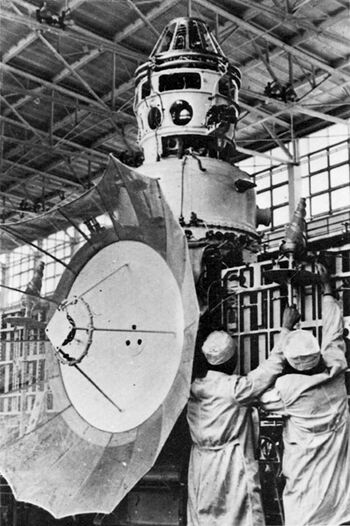Kosmos 482 facts for kids

Assembly of Venera 8, a similar craft
|
|
| Names | Kosmos 482 main bus |
|---|---|
| Mission type | Delivery of a lander to Venus |
| Operator | Soviet Academy of Sciences |
| Mission duration | Launch failure |
| Spacecraft properties | |
| Spacecraft type | 3V (V-72) no. 671 |
| Bus | 3MV |
| Launch mass | 1,180 kilograms (2,600 lb) (including the descent module) |
| Start of mission | |
| Launch date | March 31, 1972, 04:02:00 UTC |
| Rocket | Molniya 8K78M |
| Launch site | Baikonur 31/6 |
| End of mission | |
| Decay date | 5 May 1981 final sections of 1972-023A |
|
|
|
| Mission type | Venus lander (intended) Earth Impactor (accidental) |
|---|---|
| Operator | Soviet Academy of Sciences |
| Mission duration | Launch failure |
| Spacecraft properties | |
| Launch mass | 495 kilograms (1,091 lb) |
| Start of mission | |
| Launch date | March 31, 1972, 04:02:00 UTC |
| Deployed from | Separated from the main bus |
| Deployment date | mid-June 1972 |
| End of mission | |
| Decay date | Reentry 06:04-07:32 UTC 10 May 2025 |
| Orbital parameters | |
| Reference system | Geocentric |
| Regime | Low Earth orbit |
| Semi-major axis | 6,588 kilometres (4,094 mi) |
| Perigee | 120 kilometres (75 mi) 00:35 UTC 10 May 2025 |
| Apogee | 166 kilometres (103 mi) 00:35 UTC 10 May 2025 |
| Inclination | 51.95° |
| Period | 88.7 minutes |
| Epoch | 00:36 UTC 10 May 2025 |
Kosmos 482 was a space probe from the Soviet Union that tried to go to Venus. It launched on March 31, 1972, but it couldn't leave Earth's orbit. Because of this, it was renamed "Kosmos 482". "Kosmos" was a name given to satellites that stayed in Earth's orbit.
After reaching a temporary orbit around Earth, the Kosmos 482 spacecraft split into two main parts. One part was the main spacecraft (called 1972-023A). The other part was the "descent craft" (called 1972-023E), which was supposed to land on Venus. The main spacecraft and its rocket parts fell back into Earth's atmosphere between 1972 and 1981.
The descent craft, which weighed about 495 kilograms (1,091 lb), was designed to be very strong. It could handle extreme forces and pressures when entering the atmosphere of Venus. However, because it was so old, it likely broke into pieces when it fell back to Earth.
Contents
What is Kosmos 482?
The name "Kosmos" was given to Soviet spacecraft that stayed in Earth's orbit, even if they were meant to go somewhere else. Kosmos 482 was supposed to be a space probe for Venus. We know this from old Soviet documents and other sources.
Usually, Soviet planetary missions first went into a temporary orbit around Earth. From there, a rocket engine would fire for about four minutes to send the probe towards its target. If the engine failed or didn't fire long enough, the probe would stay in Earth orbit. Then, it would be given a "Kosmos" name.
The Launch and What Went Wrong
Kosmos 482 was launched by a Molniya rocket on March 31, 1972. This was just four days after another Venus probe, Venera 8, was launched. Kosmos 482 was probably designed to be very similar to Venera 8.
After reaching Earth's temporary orbit, the spacecraft tried to launch towards Venus. But something went wrong. An incorrectly set timer caused the rocket's final stage to shut down too early. This stopped the probe from escaping Earth's orbit.
The spacecraft then broke into four pieces. Two pieces stayed in a low Earth orbit and fell back to Earth within two days. The other two pieces, which were likely the main probe and its engine, went into a higher orbit.
Pieces Falling to Earth in 1972
Four hot, red-glowing metal spheres, each weighing about 13.6-kilogram (30 lb) and 38 centimetres (15 in) wide, crashed in New Zealand on April 3, 1972. They landed within a 16-kilometre (10 mi) area near Ashburton, New Zealand. These spheres burned holes in crops and made deep marks in the ground, but no one was hurt. Another similar object was found in New Zealand in 1978.
According to Space law, space junk should be returned to the country that owns it. However, the Soviets said they didn't know anything about the satellite and didn't own it. So, the pieces belonged to the farmers whose land they fell on. Scientists in New Zealand studied the pieces. They found manufacturing marks and special welding on the titanium, which showed they were from the Soviet Union. The scientists believed they were gas tanks from the rocket that launched the satellite.
The Descent Craft's Return in 2025
The last remaining piece of Kosmos 482, the descent craft, fell back into Earth's atmosphere on May 10, 2025. It re-entered somewhere between 51.95 degrees north and south latitude.
The European Space Agency (ESA) reported that they did not see the descent craft with radar when it was expected to pass over Germany. This meant it had likely already fallen earlier that morning. The Russian space agency Roscosmos later confirmed that the lander crashed into the eastern Indian Ocean west of Jakarta, Indonesia.
See also
 In Spanish: Cosmos 482 para niños
In Spanish: Cosmos 482 para niños
- List of missions to Venus
- Soviet space program
- Space debris
- List of space debris fall incidents


